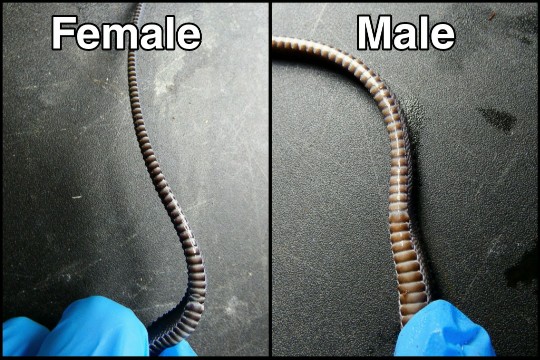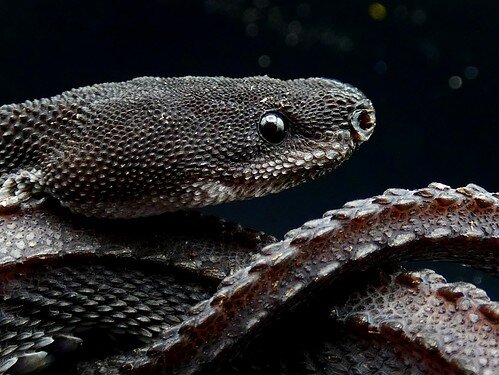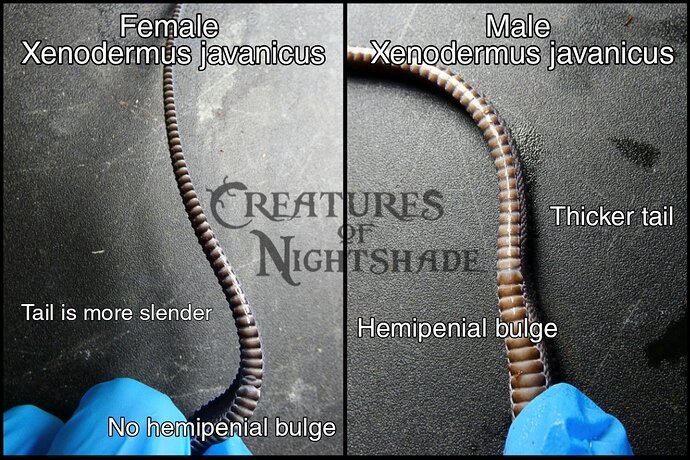Family: Xenodermidae
Scientific Name: Xenodermus javanicus
Lifespan: 8-10+ years
Size: Average 2 - 2 1/2 feet
Habitat and Distribution: Southeast Asia; inhabiting swamps, marshes and rice paddies
Xenodermus javanicus, or the Dragon snake, is a small and unique species of snake renowned for its unusual but fascinating appearance, especially in their dorsal scalation. With three rows of keeled scales, the Dragon snake takes on the features of a dragon, from which their name originates.
Scales of the Dragon snake (Xenodermus javanicus) | © 2021 Creatures of Nightshade
They can also exhibit a particularly interesting behavior when handled: they will stiffen their entire body, as if they were turned into stone! While they have a more reclusive nature, they are incredible to observe when they come out during the night to hunt and explore.
Disclaimer
Dragon snakes are not yet established in captivity, thus all available specimens are currently wild caught imports. If you are interested in keeping this species, it is highly recommended that you have at least some experience establishing wild caught imports. While a small handful of people have been successful in keeping Dragon snakes, due to their current status in captivity, this species is best suited for advanced keepers until established captive bred specimens are more readily available.
Enclosure
Due to their small size, Dragon snakes do not require elaborately large enclosures. I have been keeping smaller Dragon snakes in 15qt. Sterilite locking tubs, and larger snakes in 32qt. tubs; however, I am currently experimenting with naturalistic palladiums that will mimic their wild environment, with future plans to include a running water feature. I provide them with a few hides, a bit of artificial foliage for extra cover, and a water dish buried up to the rim with substrate. When first establishing Dragon snakes, I highly suggest keeping the water dish under their hide, as this allows them to feel more secure while hunting. Over time however, your Dragon snake should begin to feel more comfortable with their surroundings and venture outside of their hide(s). Patience is key when keeping this species.
Substrate and Humidity
Dragon snakes require consistently high humidity at all times and often spend a majority of their time underground. In order to satisfy their semi-fossorial (burrowing) nature and maintain humidity levels of 90%+, I prefer to use an organic potting soil and vermiculite blend for substrate. It is crucial that you are not using a substrate that you must constantly modify by adding water to maintain humidity levels, as minimal interaction with this species is best to avoid additional stress. I add two cups of water upon initially placing my substrate and then only mist once every week or two for a few seconds each time. Dragon snakes are more vulnerable to skin diseases, thus it is important to keep the environment as sanitary as possible. Adding a drainage layer to allow for a more even distribution of moisture through the substrate is highly recommended to help maintain humidity.
Dragon snake (Xenodermus javanicus) | © 2021 Creatures of Nightshade
Heating
Dragon snakes do not require external heat and should ideally be kept in a temperature-controlled room between 75-77°F. High temperatures are detrimental to this species, so do not overheat them! If your house is kept cool and you are unable to maintain a room temperature within this threshold, you can mount a 60W CHE (ceramic heat emitter) ABOVE the enclosure to meet their heating requirements. You will have to calibrate the temperatures by adjusting the height from the CHE to the enclosure, starting from the farthest distance and gradually moving closer as necessary. Always use a thermostat with any and all heat sources.
Diet and Feeding
Author’s note:
The information in this section was revised on August 27th, 2022 to accommodate for the adjustments I made in my approach to feeding Dragon Snakes after conducting a study on their dietary needs. If you would like to read about the study and the changes that were made, click here .
Feeding Dragon snakes is very straight-forward as long as they have settled in well. In the wild, reports suggest that their diet consists primarily of tadpoles, frogs and small fish. However, in captivity, I strongly recommend offering a variety of tadpoles and frogs as the staple of their diet, with fish being fed as a supplement only.
Tree frogs in the family Hylidae are an excellent choice, as they are very easy to care for and are hardly ever refused by Dragon snakes. Tree frog tadpoles are perfect in size for small to mid-size Dragon snakes (less than 18 inches long), with adult tree frogs being suitable for larger Dragon snakes. Young American Bullfrog ( Lithobates catesbeianus ) tadpoles are another great option, especially for adult female Dragon snakes, who are larger in size and build compared to their male counterparts. With that said, the American Bullfrog is a very large frog species, and their beefy tadpoles can reach up to 6 inches in length, which is much too big for any size Dragon snake to consume. Therefore, American Bullfrog tadpoles that are at or under 3.5 inches in length work best for adult female Dragon snakes.
The quantity of tadpoles and/or frogs offered in one sitting will depend on the feeder’s size and species, as well as the size of the Dragon snake. Small to mid-size Dragon snakes seem to do best when fed about 5 to 7 tadpoles or frogs that are about the size of their head. On the other hand, larger adult Dragon snakes prefer to dine on 1 - 2 mature tree frogs and/or American Bullfrog tadpoles, which can be around 2.5x bigger than their own head!
In addition to tadpoles and frogs, fish should also be offered as a supplement in the Dragon snake’s diet. With that said, I strongly advise against feeding fish as a primary staple of their diet for nutritional reasons. While I have not been able to find or produce comparative nutritional data for tadpoles and frogs, my observations over the years have led me to conclude that tadpoles and frogs are not only strongly preferred over fish, but that they are also more nutritionally beneficial for Dragon snakes, as well. Click here to read the study I conducted comparing the nutritional differences I observed between prey items.
When offering fish as a supplement, it is important to know that certain species of fish contain an enzyme called thiaminase, which breaks down thiamin (vitamin B1). Thiamin is a crucial vitamin that all living things need to metabolize in order to function and grow. Mosquito fish (Gambusia affinis), Guppies (Poecilia reticulata) and Platies (Xiphophorus maculatus) are all species of fish considered safe feed in regards to their thiaminase content. If you would like to learn more about thiaminase and the fish that contain them, click here. To minimize potentially stressful interactions with my Dragon snakes, I place the feeders in deep Tupperware dishes filled with 5 parts fresh water and 1 part tank water. Simply bury the water dish up to the rim with substrate and place in a dark, covered area where the Dragon snake will feel comfortable hunting their prey.
Additionally, if you are using a clear Tupperware container to harbor the feeder fish, I strongly suggest placing a clean, dry paper towel underneath it to provide a contrast in color between the bottom of the container and the fish, which makes them easier to see their prey and therefore hunt more effectively. You can also opt to use a bright colored water dish that produces the same effect. I have used both methods and it appears to have been an incredibly helpful aid in feeding this species.
Your feeder tank(s) should be kept pristine at all times. I do 25% water changes once a week to keep ammonia, nitrite and nitrate levels at 0ppm. If you are not an aquarist, I strongly recommend using the API Freshwater Master Test Kit to test your water parameters so that you may become familiar with how to keep a healthy, happy feeder colony. You will want to set up and cycle your tank one month before adding any tadpoles or fish.
Additionally, while they may be feeders, all life deserves to be treated with respect and given the best quality of possible. I offer plenty of hides, plants and enrichment for my feeder colonies and feed them high-quality food. Your colony will not only breed better this way, but the more they are happy and thriving, the more healthy and nutritious they are for your Dragon Snake.
Treating for Parasites
One of the biggest concerns that comes with all wild caught snakes is the potential parasite load they often bring. External parasites are easy to detect and relatively simple to treat, and there are various online resources on how to treat them – but the same cannot be said for internal parasites. Many inexperienced keepers that acquire a wild caught import believe the best course of action is to rush them to their veterinarian for an in-depth examination. Unfortunately, the stress they are put through as a result of the veterinary visit is often a major cause for decline and eventually death . When keeping wild caught snakes, it is crucial to avoid stressing them as much as possible, and this includes being poked, prodded and excessively handled by a vet. This is where experience comes into play. Knowing how to examine and identify potential issues with your snake and how to treat them without rushing them to the vet is extremely helpful in assuring the survival of such sensitive animals. In order to do so, I highly suggest establishing a good relationship with your herp veterinarian . I am able to treat all snakes for parasites at home because my veterinarian prescribes the medication via Telemedicine, allowing me to receive the necessary medication for my wild caught imports without having to put them through the stress of a long drive and physical examination. Additionally, I recommend treating new groups of tadpoles and fish for parasites a week prior to feeding them off.
Sexing Dragon Snakes
Sexing Dragon snakes is relatively simple if you know what to look for. You do not want to pop or probe these snakes as they are very thin and fragile, and the risk of hurting them is too great. Instead, tail sexing is a much easier and less invasive method of sexing your snake. Females can be distinguished from males as they are heavier-bodied, have a more slender tail, and lack a hemipenial bulge. Males on the other hand are more slim-bodied, have a thicker tail and a distinct hemipenial bulge. See the image below for reference.

Tail comparison between male and female Dragon snakes (Xenodermus javanicus)
© 2021 Creatures of Nightshade
Breeding Dragon Snakes
Very few keepers have been successful in breeding and hatching Dragon snakes in captivity. Sergey Kudryavtsev and Vasyliy Latyshev were able to breed and produce a clutch of five eggs from X. javanicus, but a fault in conditions during incubation had hatched unviable young that passed within two days of hatching. Breeding attempts for X. javanicus are currently in the works with my group of 3.4 (three males, four females). Dragon snakes breed during the monsoon season (November through March), thus to replicate optimal breeding conditions, we have introduced two new aspects of husbandry for the best chance of success: a timed misting system to replicate rain, and a gradual reduction in the air pressure of the room to simulate the pressure system during the monsoon season. If breeding attempts are successful and a clutch is produced, we will be incubating them at room temperature in damp vegetation to closely mimic conditions in the wild.
Additional Information
As with most wild caught imports, it is important to limit handling to only when medically necessary. I rarely handle my Dragon snakes for interaction or personal benefit. While this may change when captive bred status is obtained, for now it is best to avoid putting these snakes through any unnecessary stress. They are particularly fragile and will quickly decline under stress.
I also recommend keeping them in a dark or dimly lit room. I allow a small amount of natural light to peek indirectly through a window to provide a natural daylight cycle. Absolutely no artificial light sources; this is a semi-fossorial nocturnal species, and light should only be provided through natural means to help them regulate.
In summary, Dragon snakes are a fascinating species to keep for those who are capable of doing so. While they are best suited for advanced keepers due to their current status in captivity, I hope the information provided in this guide will help the small community of those who keep them in assuring they thrive in their care. With the persistent efforts of dedicated keepers, perhaps we will see more captive bred hatchlings in the future.


 thanks for all the information and the lovely picture. Never heard much less seen one of these fellas before.
thanks for all the information and the lovely picture. Never heard much less seen one of these fellas before.



